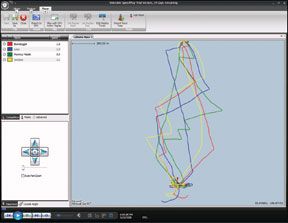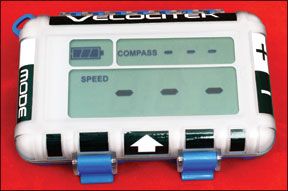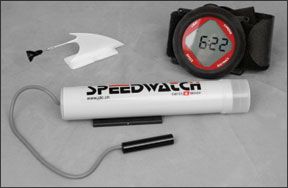The marine GPS receiver in its purest form is meant to answer three important questions: Where are we? What direction are we going? How fast we are going? For the philosophical navigator, the answers to the first two questions may be the most intriguing, but for the Melges 24 racer bound for the finish or the Caribbean cruiser hoping to drop anchor before sundown, the digits beside the word “knots” are much more compelling. So it should come as no surprise that a new breed of GPS devices-appealing directly to our need for speed-are making steady inroads into the sailing market.

Although the racing rules for many sailboat classes ban the use of portable GPS devices during racing they are popular training tools, and many local fleets make exceptions to allow the use of GPS. Compact, watertight, and wireless, battery-powered GPS units are particularly useful on smaller boats.
The earliest GPSs were poor tools for tracking speed. Fixes were deliberately imprecise (for the sake of national security) and they erratically averaged speed by using the distance/time formula and a breadcrumb-trail of trackpoints. By comparison, a modern GPS receivers has very precise fixes and can almost instantaneously calculate speed by monitoring the frequency shifts (Doppler shift) of the satellite signals it tracks. Just as a train whistles rising pitch can be used to calculate how fast a train is approaching the station, the frequency change in signals from GPS satellites can be used to determine how fast a boat is going. Advanced GPS chipsets in two devices reviewed for this article can calculate speed and heading solutions four times per second. This often yields results that are more accurate than can be displayed by typical sailing instruments, since these are usually limited to resolutions of 0.1 knot and 1 degree.
As any navigator knows, GPS devices calculate speed over ground (SOG) and course over ground (COG), not speed through the water, which requires a knot log to measure. Although sensors that accurately measure speed through the water, wind direction, and wind speed are standard for high-level racing, speed over ground and course over ground is sufficient for many racers. Among other things, SOG and COG can help define optimum points of sail, refine sail or hull trim, reduce skin drag or leeway, and judge the best time to tack. Combined with a magnetic compass, COG and SOG can also help quantify the effects of a cross current.
And, as we found with two of the devices tested for this article, with the right firmware and software, this GPS-based data can be displayed, logged, and later reviewed in ways that makes it useful to sailors of all levels.
What We Tested
Practical Sailor testers recently spent a week experimenting with three handheld products geared toward performance sailors. Unlike conventional portable GPS units, which have relatively small displays and deliver a wide range of navigational data, these products display relatively large digits that can be read from a distance, and the view options are limited to those that relate exclusively to speed and racing performance. Latitude and longitude are nowhere to be found until you download the data for review on a computer. In addition, the rate at which data is updated in these devices is faster than youll find in many multi-purpose GPS devices.
Two of the devices we reviewed, the SC-1 and the SpeedPuck, are made by Velocitek, a company founded by surfer and windsurfer Alec Stewart, who left Stanford Engineerings Aeronautics and Astronautics PhD program to start the business. Both devices use GPS satellite signals to monitor speed and performance. The third product, the Speedwatch, has no GPS receiver, relying instead on a tiny propeller mounted on the hull to record actual speed through the water. The data is then delivered wirelessly to a wristwatch display.
Testers also experimented for a few hours with SailClever, a relatively new smart-phone application that can be wirelessly linked (using Bluetooth) to a GPS receiver and other onboard instruments to serve as a handheld tactical computer. The product, which was still in testing at the time of this article, is reviewed separately on page 30. PS did not get the chance to evaluate the Rockbox AMPD (www.rockcitymarine.com) and the Nauteek (www.nauteek.com), two products that perform similar functions as the Velocitek SC-1. PSplans to review these products in a future article.

How We Tested
The products were evaluated based on three chief criteria-ease of installation, performance on the water, and durability. Because the SpeedPuck and SC-1 also allow racers to download data for evaluation on a computer (Windows), testers also rated them on this function.
For the installation review, testers installed the units on a 1974 ODay Javelin, an Uffa Fox design and an early ancestor of todays planing skiffs. The on-the-water evaluations took place over the course of six days, and the units were first tested independently and then together while sailing on the Javelin. Sailing speeds ranged from 1 to 9 knots. High-speed testing on a powerboat ranged between 15 and 30 knots.
Screen visibility was compared in bright sunlight, both with and without sunglasses, and at night. For battery testing, any automatic shut-off features were disabled and the units were left on until the battery signal indicated an empty battery. For the durability testing, the display components went through our usual routine for handheld electronics: Put in the oven to 140 degrees for 30 minutes, placed in a freezer at 15 degrees for four hours, subjected to five minutes of direct jet spray (approximately 45 pounds per square inch) from a garden hose, submerged 3 feet underwater for 30 minutes, and dropped on each side on a fiberglass deck from 3 feet height. All of the units passed the durability tests with flying colors. Comparison data and test results in the other areas appear on the chart on page 28.
Speedwatch
Developed by JDC Electronics in Switzerland and distributed in the U.S. by Ocean Equipment, the Speedwatch comprises three components: A tiny propeller that mounts on the bottom of the hull in a place of clean water flow, a transmitter that needs to be mounted above the water and 12 inches from the propeller, and the watch-like display that can be worn on the wrist or leg, or mounted on the boat.
The transmitter (powered by a 9-volt battery) picks up magnetic pulses from the rotating propeller and wirelessly delivers the data to the display, where it is processed and displayed. The watch (powered by a long-life lithium battery) must be no more than 13 feet away from the small transmitter, not a problem on most small boats.
One neat feature is that the system requires no wires or holes in the boat. Testers used the removable fin (photo below) mount, which easily slides onto a small permanent mount. (Three locations were tried.) Two other mounting options are provided, and all make it fairly easy to remove the propeller when its not in use.
Anyone familiar with a digital watch can use the nine-page manual and figure out the four buttons that select the display modes. Surprisingly, this was the only device tested that had a backlight for use at night, although testers had to view the screen at an angle when using the light. Speed is displayed one of four ways: instantaneous speed, balanced speed, and the maximum and average speeds over a timed run. The balanced speed is essentially a damping feature, displaying the average speed during a user-defined interval, between 2 and 60 seconds. It also functions as a watch, stopwatch, and countdown timer with audible signals for race starts.
Unlike the other two devices tested on the water, this is the only one designed to deliver speed through the water. This ability would be very useful for getting instantaneous readouts to help gauge the effects of weight placement or sail trim. Comparing this speed data with speed over ground from GPS, you would also be able to gauge the effects of current.
However, at speeds of less than 6 knots, readings were inconsistent, at times registering less than 2 knots when the boat was clearly moving much faster (confirmed by GPS). Tests at higher speeds on the powerboat showed more consistent readings.
Bottom line: This Speed Watch is compact, easy to install and use, and its battery life far exceeds that of the two GPS-based products. However, testers concluded that the device, with several potential failure points, offered little advantage over the GPS-based devices to the average sailor.
Velocitek SC-1
Predecessor to the SpeedPuck, the Velocitek SC-1 includes the same speed and heading functions found in the SpeedPuck and adds several other functions, including velocity made good (VMG), a “tactical compass,” start timer, distance to line, and the ability to display two functions at once.

Enclosed in a rugged, watertight box with two latches, the SC-1 is heavier and bulkier than the SpeedPuck and has four buttons. These watertight capacitive touch sensors, designed to stand up to the extreme forces of a 25-plus-knot capsize, introduce unnecessary complications for the less-than-10-knot crowd. (When you have to read the manual to figure out how to turn something on and off, something is amiss.) Because the buttons can be activated by splashing water, they are programmed to lock after periods of inactivity or when a minimum speed is reached.
Briefly tempted to subject the SC-1 to more rigorous impact-resistance tests, testers instead disabled the auto-lock feature (via the Control Center software with a computer).
Once you master the button controls , the SC-1 can be put to good use on the race course. Both the tactical compass heading and the VMG functions are based on a reference wind direction that is manually programmed into the SC-1. Once the referenced wind is set, the tactical compass mode displays what is effectively the relative wind angle, while the VMG function indicates the boat speed upwind or downwind.
The distance-to-line function requires the sailor to enter marks as close as possible to the committee boat and pin-ends of the start line. Once these points are entered, the display will indicate the perpendicular distance to the start line from your boat. The distance is accurate to between .75 and 3 meters, depending on the number and location of the satellites in view at the time.
As with the SpeedPuck, the race data can be downloaded and evaluated using Speed Play or the bundled GPS Action Replay.
Bottom Line: Plan to spend some time with the manual to make the most of this unit. The more advanced racer will appreciate the VMG and distance-to-line functions, but don’t expect your crew to master the button-pushing basics without some initial cursing under their breath.
SpeedPuck
The SpeedPuck could be considered a light version of Velociteks SC-1, delivering only the most essential data to sailors who refuse to touch an owners manual. It uses the same 16-channel GPS chipset (U-blox Antaris LEA-4A) as the SC-1, but it displays only three key pieces of data: Speed (maximum or maximum 10-second average), heading, and windshifts. Round, with a screw-on back sealed with an 0-ring, the SpeedPuck is well engineered to withstand abuse. Its display is easier to read than the SC-1, and its single button is much simpler to use than the Velociteks recalcitrant touch sensors. It also has a blank-screen log mode that simply records data for later replay, useful in races that prohibit GPS aids.
Installation is fast and easy. Just stick the adhesive-backed 3M Dual Lock hook-and-loop mounting pad wherever you want to put the device. Other mounts are available. The SpeedPuck also has a wrist lanyard, but it is too big to be considered a pocket instrument.
One of the SpeedPucks key features is the way it presents heading data. As soon as you hold a compass heading for 20 seconds, it locks on that course and a single bar appears on the display, centered at the 12 oclock position. Any significant variation from that heading is indicated by additional bars to the left or right of the 12 oclock position on the puck; each bar represents three compass degrees.

While sailing, this display offers instant feedback on slight course changes, which can also help detect wind shifts. Two bars to the right (clockwise) from 12 oclock, for example, means the boat is heading 6 degrees to starboard of its original course. If it is on port tack at the time, and the tell tales are still streaming nicely, then the boat is getting headed. If we hold this new course for 20 seconds, the SpeedPuck resets, again showing a single bar at 12 oclock. This delay would be a problem when racing, but for tweaking trim and basic training, the system works well, and is easier to use than simple compass bearings.
The SpeedPuck was the testers favorite on the water. It was dead simple to set up and easy to use. A couple of times as the test boat ghosted in very light winds, the heading indicator bar disappeared for several seconds. According to the maker, sudden changes of direction or speed can have this effect.
Off the water, the testers used the free downloadable Velocitek Control Center to modify the SpeedPucks default settings. The software lets users specify compass deviation, change the rate of position logging, and alter how frequently speed and heading solutions are updated. A bundled third-party program called GPS Action Replay lets users replay and evaluate logged data, but the track data (a nearly invisible light yellow color at low speeds) is hard to interpret, and the graphics are uninspiring.
Testers also tried Velociteks more user-friendly SpeedPlay software ($49) to review and manipulate the logged data. Once it was installed, the program made it very easy to download recorded data from multiple SpeedPucks or SC-1 units and replay a race. The user can easily drag and drop marks on the plotted routes, and the track can be exported to common formats (KML and GPX) for use with charting software, or mapping tools like Google Earth.
Bottom line: Rugged, easy to install and use, the SpeedPuck is recommended for club racers and small-boat sailors looking for a fun practice tool that monitors speed. Serious racers will long for some of the advanced features of the SC-1, but for quick and easy evaluation of speed over ground, post-race evaluation, and a reasonable price, the SpeedPuck fits the bill.
Conclusion
While there may be a market for the Speedwatch for kiteboarders, windsurfers, and high-speed sailors, based on our testers experience, we don’t recommend it for most sailors. So that leaves us with the Velocitek gear-or the familiar handheld GPS.
If all you need is heading, average speed, and an ego-boosting logged maximum, the basic handheld Garmin GPS units-take the aging 76CSx ($250) for example-will do this and a whole lot more. And virtually all GPSs today let you download and analyze tracks with a range of software.
So, if you need a GPS device anyway, why shell out $250 for the SpeedPuck, or almost twice that for the SC-1? The chief advantages of the Velocitek devices are cleaner designs, bigger readouts, much more rugged housings, faster updates, a dead simple interface, and some fun software to play with after a race. The firmware is designed with sailors in mind, allowing them to easily follow wind shifts, and, with the SC-1, tap into more advanced functions like the tactical compass and distance-to-line. We were also very impressed with the people in tech support, who understand the needs of sailors.
The SpeedPuck, in particular, will make a good training tool for todays young sailors, who-for better or worse -are intrigued by all things digital.
The SpeedPuck and SC-1 will give around-the-buoy sailors the ability to quickly quantify performance without spending a small fortune, but they are no replacement for wind and through-the-water speed sensors.
Ultimately, sailing involves wind and water, and without any true environmental data, the sailor must trust his senses and instincts. It goes without saying that the last two items, which cost nothing but time on the water, are still the sailors most valuable tools.







































